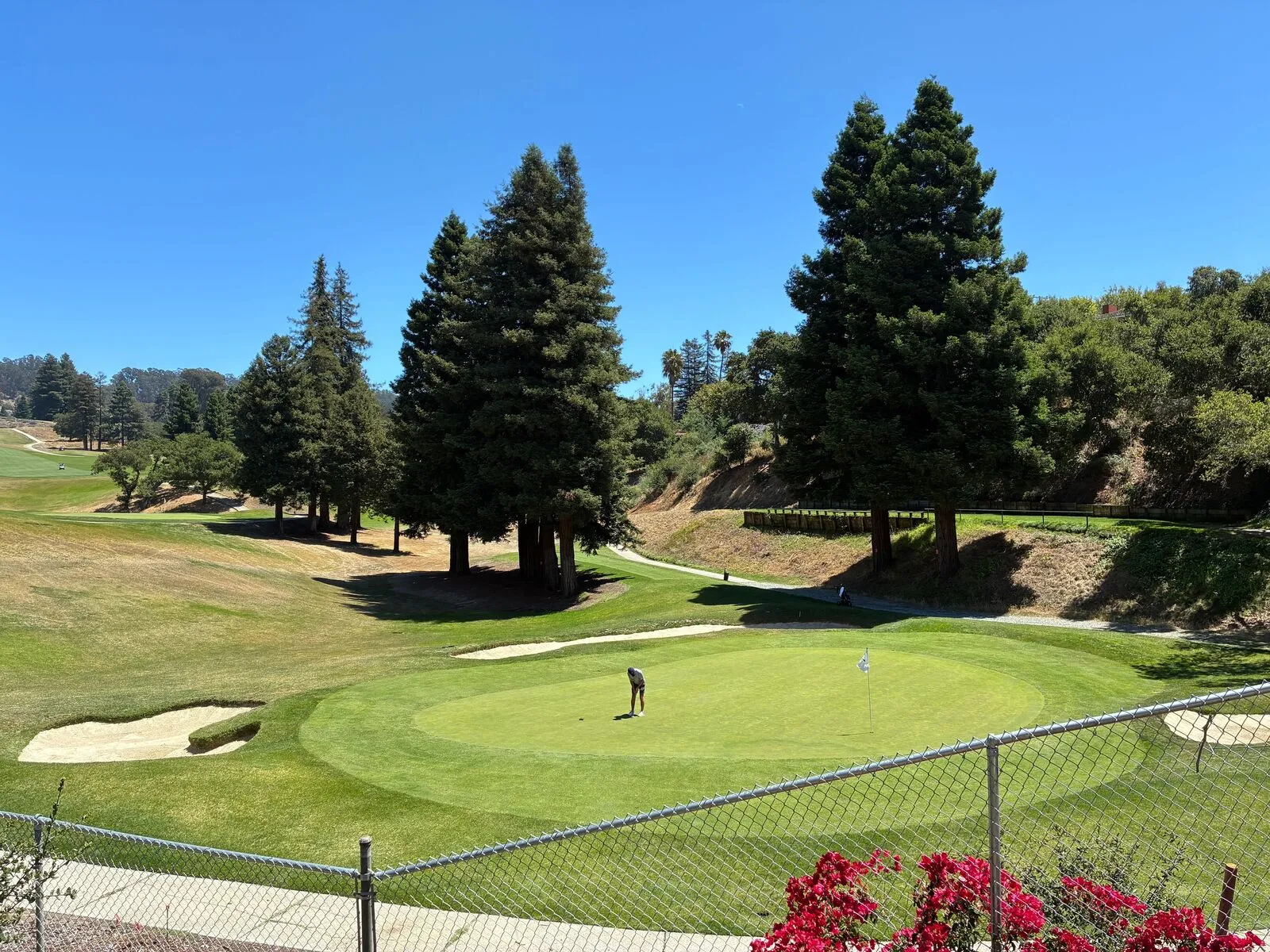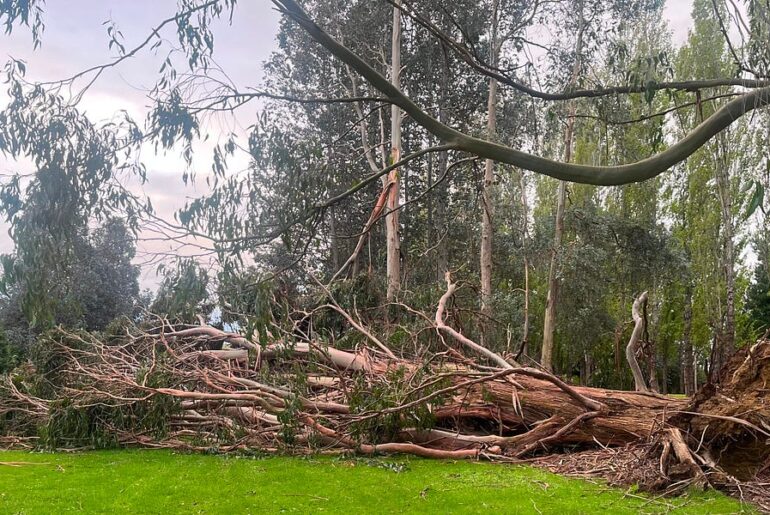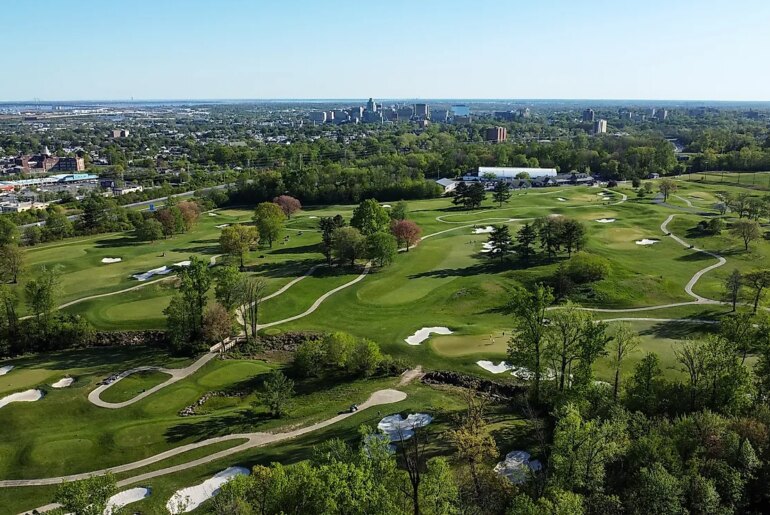When Ana Vizzo moved into her East Oakland home five years ago, the pandemic had just started, and the world was chaotic, but the view from her backyard was serene.
A zig-zag of tall redwood trees growing a few hundred feet from her property was perfectly framed by her living room window. From their backyard deck, Vizzo and her husband could watch hawks perch in the branches and squirrels zip around the tree trunks. The view of the redwoods quickly became one of the things they loved most about their house.
So when Vizzo received a letter on July 7 from the city of Oakland informing her that the trees were going to be cut down, she was alarmed.
The letter, from the Public Works Department’s Tree Section, explained that Sequoyah Country Club, which owns and manages the golf course where the trees are growing, had applied for a permit to remove 175 redwood trees. Vizzo’s family and their neighbors, including about 200 other property owners, were being offered a chance by the city to give input before a decision was made about whether to grant the club a permit to remove the trees.
“What they’re doing is wrong,” said Vizzo in a recent interview.
Vizzo and other neighbors believe the trees should be preserved. She has pointed to the city’s Protected Tree Ordinance, which calls for preserving certain kinds of trees because they “have significant psychological and tangible benefits for both residents and visitors to the city,” and because “trees contribute to the economy of the city by sustaining property values,” among many other reasons.
Under city law, protected trees in Oakland include all trees with a nine-inch or greater diameter trunk at a person’s chest level. The exceptions are eucalyptus and Monterey Pine because of they pose a fire hazard. Oakland allows protected trees to be cut down, but only with a permit, and permits have to meet stringent requirements.
Over the past few weeks, Vizzo has gotten dozens of her neighbors to sign a petition opposing the tree removals and launched an online petition that’s drawn hundreds more signatures, some from people outside of Oakland. She’s also mobilized neighbors to attend a community meeting at the club.
But representatives for Sequoyah Country Club say the tree removals are part of a larger landscaping plan, a sweeping renovation of their golf course that will make it more environmentally friendly, require less water, and constitute a big improvement to the 18-hole attraction.
While they’re planning to cut down 175 redwoods, the country club’s president, Jason Hom, and general manager, Katie Hall, told Oaklandside the club plans to plant hundreds of native oak and laurel trees as replacements for the redwoods they remove.
They already have a tree nursery on site where they’re growing saplings. While it will create a different landscape, the club says the oaks will consume less water and support wildlife. “We’re preserving just as many redwoods,” added Hall, about some of the trees they don’t plan on cutting down.
The club also points out that the redwoods were all planted by club staff between 1915 and the 1980s. Some are now mature, towering conifers. Others are smaller. Before it was a golf course with redwood-lined fairways, the area was a barren cattle ranch, the original oak woodlands chopped down by early settlers.
But the redwood trees are beloved by neighbors like Vizzo, and now it’s turned into a fight between them and the club — and the City Council may soon need to get involved.
Plans for a new golf course collide with some neighbors’ sense of home
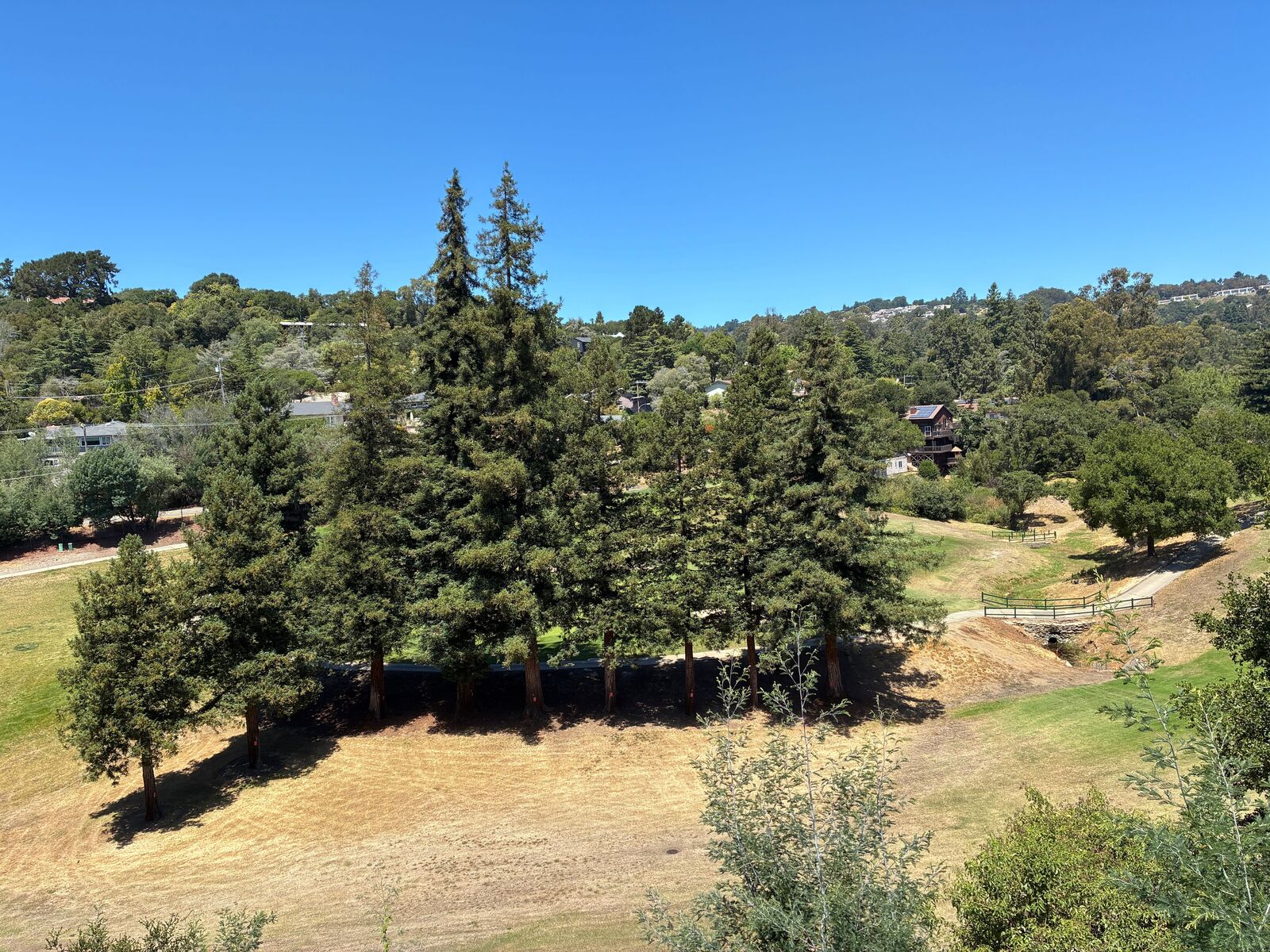 A row of redwoods visible from Ana Vizzo’s backyard. Credit: Darwin BondGraham / The Oaklandside
A row of redwoods visible from Ana Vizzo’s backyard. Credit: Darwin BondGraham / The Oaklandside
Vizzo doesn’t play golf but said she has nothing against the sport. “I actually like having them as a neighbor,” she said about the club, which occupies 142 acres in the hills surrounded on all sides by homes in Oakland’s Sequoyah neighborhood, which was named after the club. Many who live around the golf course enjoy the quiet atmosphere and the views it creates.
But Vizzo asked to visit the country club after learning about the tree-cutting plan. She met with staff, including Hall, who drove her around the course.
“Every redwood has a red tag on it,” Vizzo said, referring to the tags she saw that marked trees slated for removal.
The country club hired a certified arborist to conduct a tree inventory of its grounds last year. According to the arborists’ report, 393 trees were identified and evaluated. They include:
345 coast redwoods
37 live oaks
six cedars
Four Monterey cypress and one western sycamore.
There are also 142 blue gum eucalyptus, 31 Monterey pine trees, and six other varieties of cedar on the country club property planned for removal, but they’re not protected under Oakland law due to their non-native status and the fire hazards they pose.
The arborist classified many of the redwoods as being in “poor” or “poor-fair” health, and noted that six are dead.
Vizzo has contested this. In an email to city staff, she asked, “how many of the trees have been classified as ‘diseased,’ ‘unhealthy,’ or otherwise ‘sick’,” as this can be a justification under the city’s rules for cutting down protected trees.
“To my knowledge none of the trees are diseased or ‘sick’. However several are in poor condition and suffering from drought stress, and a few are dead,” Oakland Arboricultural Inspector Isaac Harvey, who is reviewing the club’s plans, replied in an email.
Frank Flores, a development manager with Signature Development Group, which is working with the country club on its renovations and permitting, said the redwoods don’t do well on the dry hilltop area where the golf course is located. The club plans to tear up its existing grass and replant a new variety that consumes 40% less water, and this will further stress the redwoods, he said.
The bigger picture for the club is that its irrigation system is old and failing and needs to be entirely replaced, Hom said. Leaks happen often and result in big losses of water.
A 2022 report written by the United States Golf Association for the club found that its irrigation system is “well past its useful life,” and the report recommended a full renovation. “Those that decide to piecemeal the renovation ultimately regret that decision,” the authors advised based on experiences with other courses.
“If you redo the irrigation, you have an opportunity to redo the layout,” said Hom.
The club’s leadership said they feel it’s necessary to redesign their course, making it more appealing to a new generation of golfers who will become dues-paying members. That means widening the fairways, moving earth, and other major changes — all of which require taking down some of the trees, they said.
“We’re making it more appealing to players of all skill levels and ages,” said Hall. The course will be more walkable and cater to people and families who don’t want to spend all day on the green, while also being an attraction for highly skilled golfers who want to play 18 holes.
The club has also taken big steps in recent years to become a more “family-friendly” venue, fixing up its pool and holding events like drive-in movie nights in the parking lot. They made it through the COVID shutdowns, continuing to pay their 75 employees, but there have been financial struggles in the past.
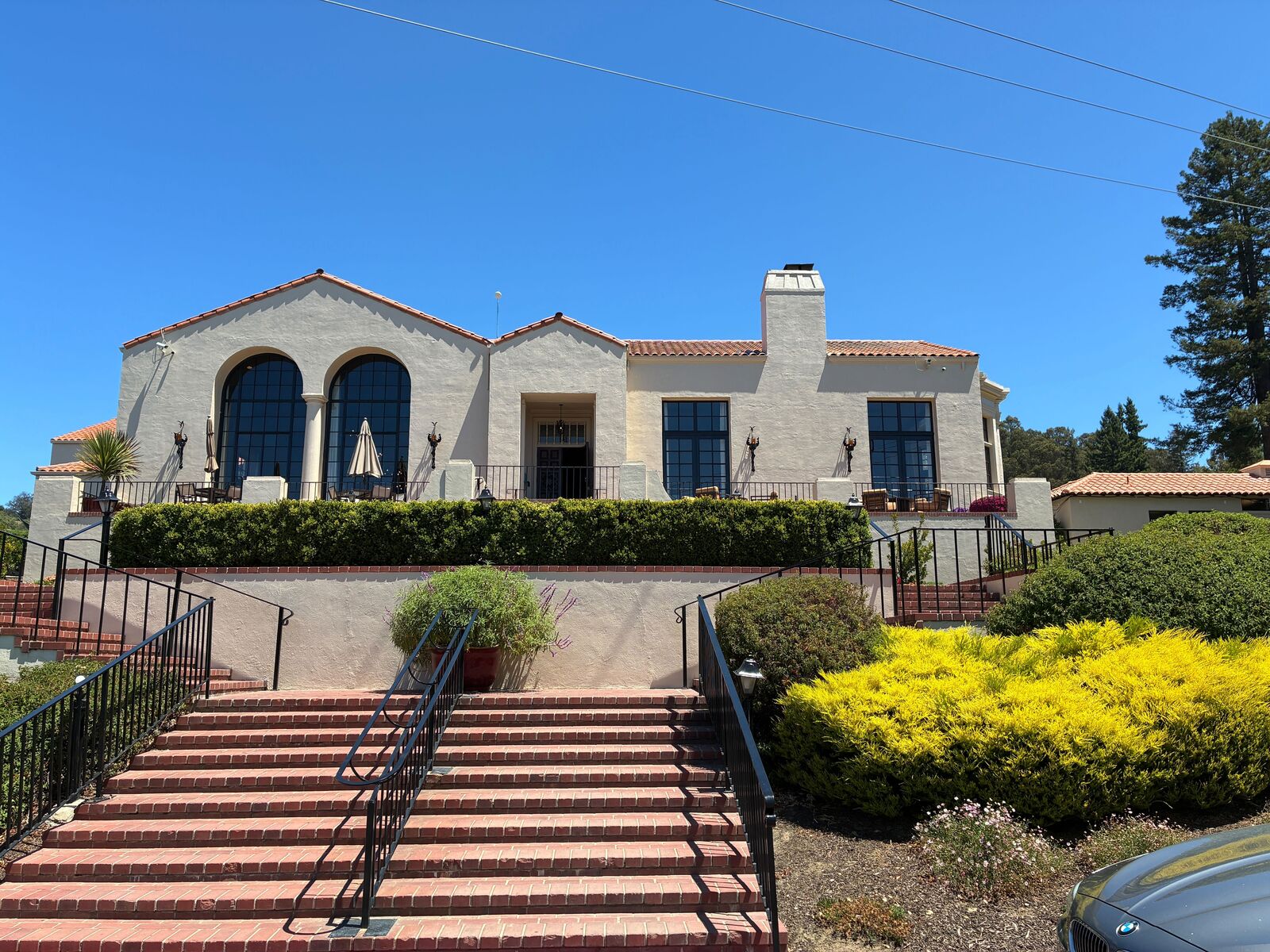 Founded in 1913, Sequoyah Country Club’s clubhouse and amenities include a dining room, bar, pool and event spaces. Credit: Darwin BondGraham
Founded in 1913, Sequoyah Country Club’s clubhouse and amenities include a dining room, bar, pool and event spaces. Credit: Darwin BondGraham
“The club has been around 110 years,” said Hall. “None of us are interested in being part of the generation that allows this to fail. We want to allow this to outlive us.”
But where the country club sees an opportunity to revitalize itself, some see a threat to beautiful environmental resources.
On Reddit, a post by Vizzo generated an outpouring of opposition to the tree removals.
“Just make sure they change the name to Stump Country Club,” one person snarkily wrote.
“They should have engaged neighbors earlier,” said Vizzo, adding that she feels like the city was getting ready to “rubber stamp” the tree removals before she got involved. From her backyard, she can see red tags on almost all of the dozen or so trees just down the hillside from her home.
In a letter to the city official responsible for reviewing the tree removal applications, Catherine Pool, another resident who lives in the neighborhood, wrote that she believes the club’s application for a tree-cutting permit lacked necessary information and that “no community engagement has been done by the applicant to explain why this removal permit is necessary.”
Pool said the club never held a meeting with community members to specifically go over the tree removal plan, justifying why each proposed cut was necessary.
“They designed a golf course without any concern for how many trees they have to remove,” she said.
Club leaders say they’ve done a lot of outreach to neighbors and followed the city’s process. In May, they put together a tree protection plan related to construction, and notices about the tree removal permits went out to all the neighbors in June, said Flores. The club also held two previous meetings with the community to talk about the renovations and answer questions.
“We’ve tried to be good stewards with our neighbors,” said Hom. “We knew going in we would have to do outreach.” But Hom said the club only started to nail down details about how many trees would need to be removed in May.
In her letter to the city, Pool also questioned the findings of the club’s arborist, who described redwoods and cedars as non-native, noting that they are native to the East Bay hills.
And she raised questions about the club’s plan to use reclaimed wastewater.
Club leaders say that at some point in the future, they want to install infrastructure capable of using wastewater to irrigate the golf course grounds, and that the redevelopment they’re planning will include some steps toward this water-wise goal, including installing “purple pipes” that signify water isn’t potable.
But Pool wrote that she believes the East Bay Municipal Utility District, which handles wastewater for the region, isn’t planning to make this water available to hills areas until at least 2050.
Flores and Hall said oak trees tolerate wastewater better, thus their desire to remove the redwoods and plant oaks.
Pool said this shouldn’t be taken into consideration as a reason to cut down the redwoods because there won’t be wastewater used after the renovation.
“Pool isn’t informed,” said Hall, who added that the club is looking into using wastewater, which could include other sources than EBMUD, and the reconstruction of the irrigation system is the right time to plan ahead for this.
An earlier attempt at compromise fell through
 Red tags mark several trees for removal on the club’s golf course. Credit: Darwin BondGraham / The Oaklandside
Red tags mark several trees for removal on the club’s golf course. Credit: Darwin BondGraham / The Oaklandside
A few days after learning about the tree removal plan, Vizzo wrote several emails to Hall expressing opposition and asking that some of the trees be spared. After consulting with the club’s golf architect, arborists, and others, Hall responded with a proposal. The country club would be willing to preserve 4 of the trees slated for removal below Vizzo’s home. “This adjustment to our plan still carries considerable cost to the club, but we believe this approach balances the concerns of your vistas with the club’s long-term needs,” a letter from the club explained.
The deal would have been “contingent on there being no objections filed,” meaning Vizzo nor anyone else could contest other parts of the plan.
“They’re asking me to sell out the community,” said Vizzo, who rejected the offer.
Hall and Hom said it was a good-faith offer to attempt a compromise with the one person who has been most outspoken. They acknowledged that they asked Vizzo to be discreet and not to tell other neighbors about any deal they might reach to keep trees near her home, and that it would be contingent on no one else appealing the project.
“We tried to come to the table,” said Hall. “She said ‘all or nothing.’” Hall said it cost the club additional time and money to see if it could revise its plan to preserve some trees.
“Their permit should be denied because the trees are healthy and their destruction could be avoided by ‘reasonable redesign’,” said Vizzo in an interview on Tuesday, citing a section of the city’s Protected Tree Ordinance.
On Tuesday afternoon, the club held a third community meeting where it pitched neighbors again on the project and took questions. The new irrigation system, landscape changes, tree removals, and new roads will not only make the club more financially sustainable for the long term, the changes will also improve fire safety in the area, they said. The replacement oaks will be more suited to the environment and have lower water use.
District 7 Councilmember Ken Houston, who represents the area, attended the meeting. He said he has been talking to residents and the club and told The Oaklandside he understands the concerns on both sides and wants to help homeowners and the club reach some kind of compromise.
If an appeal is filed by Vizzo or anyone else to object to the tree removal permits, the issue could go before the City Council, which would render a final decision.
“If I see they’re not bending, one side or another, I’ll walk away, and it’ll come to council, and council will decide,” said Houston in an interview. “But it shouldn’t go there because someone’s gonna lose.”
“*” indicates required fields

